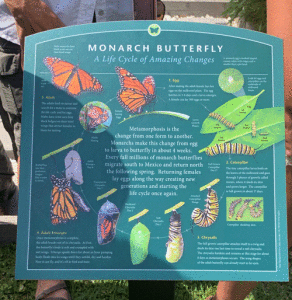
Monarch Waystation Sign at Port O’Connor School
By Ana Brown, Port O’ Connor School, May 9, 2022
Have you ever been to Port O’ Connor School? If so, have you seen our Monarch Waystation that Mr. and Mrs. Berger built? Mr. and Mrs. Berger came to our campus on May 9, 2022 to put a Waystation sign up at the front of the school. A monarch waystation is a place where you plant milkweed and other plants that produce a lot of nectar. It helps the Monarch butterflies by giving them a place to stay and lay eggs.
Blaklei Ruddick and I interviewed Mr. and Mrs. Berger, and this is what we learned from this interview:
In order to qualify for a monarch waystation, you must have milkweed and plants that produce a lot of nectar. Monarch butterflies stop and lay eggs, and also stop for nectar when they migrate.
When Mrs. Berger became involved with a Monarch Butterfly Waystation; she was fascinated with it. She decided to research them and soon created her own Monarch waystation! Then, she came to our campus and created a waystation for us!
Adult butterflies drink nectar from different plants but they especially like the Mealy Blue Sage. It produces nectar and a lot of it! They lay their eggs on milkweed so when the eggs hatch, the caterpillars can eat the milkweed.
A female monarch’s life is very short, usually 2-5 weeks. In that time, she can lay 300-400 eggs. The female butterfly produces a special glue which makes the eggs stick to the leaves. Thirty-five percent of eggs hatch when the Monarch lays the eggs. Reasons for this include infertility of the eggs, conditions such as being too hot and being eaten.
The likelihood of a caterpillar reaching adulthood is less than 10%. For 100 eggs, only about 2 caterpillars will live to become adult butterflies.
Nature takes about 98%, which makes them an important part of the ecosystem. They are foods for other living organisms such as spiders, ants, wasps, flies, crickets, grasshoppers, and many more organisms. The reason why some female butterflies lay their eggs on the underside of a leaf is because it’s cooler under there from being under the sun and also safer because some animals can’t see the eggs. It takes about four days for an egg to hatch.
Butterflies search for milkweed to lay their eggs, and if they don’t find milkweed, they won’t be able to lay their eggs. They will die without reproducing, and it doesn’t help that most of our country is being plowed, mowed, and changed to concrete, farms, and buildings. This is why most people have been building Monarch waystations, so they can increase the number of butterflies.
We are very thankful for the beautiful waystation that Mr. and Mrs. Berger built for our campus. You can drive along the road in front of our campus and see the waystation. Feel free to pull up in the driveway and read the signs.
It’s been a pleasure to learn all this information from the Bergers.
